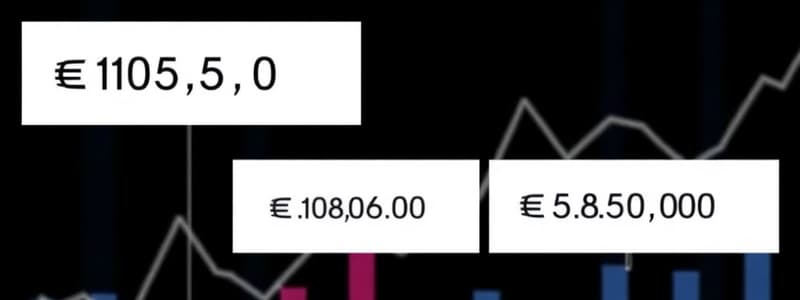Podcast
Questions and Answers
Autonomous consumption is denoted by ______ and shows the consumption which is independent of income.
Autonomous consumption is denoted by ______ and shows the consumption which is independent of income.
C
Induced consumption, denoted as ______, shows the dependence of consumption on income.
Induced consumption, denoted as ______, shows the dependence of consumption on income.
cY
The marginal propensity to consume (MPC) is defined as the rate of change of consumption as income changes, calculated as ∆C/∆______.
The marginal propensity to consume (MPC) is defined as the rate of change of consumption as income changes, calculated as ∆C/∆______.
Y
The maximum value which MPC can take is ______.
The maximum value which MPC can take is ______.
Generally, MPC lies between ______ and 1, inclusive of both values.
Generally, MPC lies between ______ and 1, inclusive of both values.
Planned investment refers to the amount a producer intends to add to her ______.
Planned investment refers to the amount a producer intends to add to her ______.
If a producer's sales exceed her planned amount, her actual investment is calculated as Rs ______.
If a producer's sales exceed her planned amount, her actual investment is calculated as Rs ______.
Ex-ante measures depict what has been ______.
Ex-ante measures depict what has been ______.
The most important determinant of consumption demand is household ______.
The most important determinant of consumption demand is household ______.
Autonomous consumption occurs even if income is ______.
Autonomous consumption occurs even if income is ______.
The relationship between consumption and income is described by the consumption ______.
The relationship between consumption and income is described by the consumption ______.
In the consumption function, the equation C = C + cY shows consumption as a function of ______.
In the consumption function, the equation C = C + cY shows consumption as a function of ______.
Ex-post measures reflect what has actually ______.
Ex-post measures reflect what has actually ______.
The basic objective of macroeconomics is to develop theoretical tools called ______.
The basic objective of macroeconomics is to develop theoretical tools called ______.
The assumption of ceteris paribus literally means ‘other things remaining ______.
The assumption of ceteris paribus literally means ‘other things remaining ______.
In this chapter, we deal with the determination of National Income under the assumption of fixed ______ of final goods.
In this chapter, we deal with the determination of National Income under the assumption of fixed ______ of final goods.
John Maynard ______ is the economist whose theory underlies the model used in this chapter.
John Maynard ______ is the economist whose theory underlies the model used in this chapter.
In National Income Accounting, consumption is an example of a component of ______.
In National Income Accounting, consumption is an example of a component of ______.
The actual or accounting values of economic items are referred to as ______ measures.
The actual or accounting values of economic items are referred to as ______ measures.
In this context, consumption may denote what people had planned to ______ during a given period.
In this context, consumption may denote what people had planned to ______ during a given period.
The total output of final goods and services in an economy is referred to as ______.
The total output of final goods and services in an economy is referred to as ______.
Flashcards
What is the purpose of macroeconomic models?
What is the purpose of macroeconomic models?
Macroeconomic models aim to explain how economic variables like national income, price level, and interest rates are determined.
Ceteris Paribus
Ceteris Paribus
The assumption of ceteris paribus means that all other variables are held constant while analyzing the relationship between two specific variables.
Ex post measures
Ex post measures
Ex post measures refer to the actual values of economic variables, such as consumption or investment, as measured in a specific period.
Ex ante measures
Ex ante measures
Signup and view all the flashcards
Aggregate Demand
Aggregate Demand
Signup and view all the flashcards
Components of Aggregate Demand
Components of Aggregate Demand
Signup and view all the flashcards
Keynesian Model
Keynesian Model
Signup and view all the flashcards
What is the focus of this chapter?
What is the focus of this chapter?
Signup and view all the flashcards
Planned Investment
Planned Investment
Signup and view all the flashcards
Actual (Ex Post) Investment
Actual (Ex Post) Investment
Signup and view all the flashcards
Ex Ante Values
Ex Ante Values
Signup and view all the flashcards
Ex Post Values
Ex Post Values
Signup and view all the flashcards
Consumption Function
Consumption Function
Signup and view all the flashcards
Autonomous Consumption
Autonomous Consumption
Signup and view all the flashcards
Marginal Propensity to Consume (MPC)
Marginal Propensity to Consume (MPC)
Signup and view all the flashcards
Autonomous Consumption (C)
Autonomous Consumption (C)
Signup and view all the flashcards
Induced Consumption (cY)
Induced Consumption (cY)
Signup and view all the flashcards
Maximum Value of MPC
Maximum Value of MPC
Signup and view all the flashcards
Range of MPC Values
Range of MPC Values
Signup and view all the flashcards
Study Notes
Determination of Income and Employment
- National income, price level, and interest rates are analyzed to understand their determinants.
- Macroeconomic models aim to explain processes determining these variables.
- Models explain factors like slow growth, recessions, rising prices, and unemployment.
- The ceteris paribus assumption is crucial when analyzing a particular variable, holding other variables constant.
- The method involves solving for one variable in terms of another, then substituting into the other equation.
Aggregate Demand and its Components
- National income accounting concepts (consumption, investment, GDP) have dual meanings.
- Ex-post measures represent actual values in a given year.
- Ex-ante measures represent planned values.
- Consumption is influenced by income.
- A simple consumption function assumes a constant rate of change in consumption as income changes.
- Autonomous consumption is the consumption that occurs even when income is zero.
- Induced consumption responds to changes in income.
- The marginal propensity to consume (MPC) is the rate of change in consumption with respect to income.
- MPC can range from 0 to 1.
- Investment is additions to physical capital and inventory changes.
- Investment decisions are influenced by factors like interest rates.
- Aggregate demand (AD) equals consumption (C) plus Investment (I) plus c.Y (where c = MPC and Y = income)
Determination of Income in Two-Sector Model
- AD = C + I, substituting values of C and I yields AD= 𝐶+𝐼+ c. Y
- Equilibrium in the final goods market (Y = AD), simplified as Y = A + cY (A =C + I)
- Autonomous expenditure (A) is the sum of autonomous consumption and investment.
- Ex-ante output (Y) equals planned aggregate demand.
- Equilibrium requires ex-ante supply equals ex-ante demand.
- Changes in inventory represent the difference between planned and actual output.
Determination of Equilibrium Income in the Short Run
- Equilibrium in a single market (in microeconomics) is determined by the intersection of demand and supply curves.
- Macroeconomics analysis has two stages: analyzing equilibrium with a fixed price level, and then allowing the price level to vary.
- Equilibrium is when aggregate demand equals aggregate supply.
- A 45-degree line represents aggregate supply in a simple macro model.
Effect of an Autonomous Change in Aggregate Demand
- Changes in aggregate demand affect the equilibrium income.
- Autonomous changes in consumption (C) or investment (I) shift the aggregate demand (AD) curve.
- This causes a change in equilibrium income (Y).
The Multiplier Mechanism
- The increase in equilibrium income exceeds the initial change in autonomous expenditure (i.e., multiplier effect)
- The multiplier effect occurs because an initial change in spending leads to a chain reaction of further spending.
- Consumption increases with income, further increasing demand, causing further output changes, leading to a larger income change.
- The investment multiplier (ΔY/ΔA) equals 1/(1-c) where c=MPC (marginal propensity to consume).
Paradox of Thrift
- Increased saving (and thus a higher marginal propensity to save, or MPS) can lead to decreased total output, income and reduced aggregate spending.
More Concepts
- Full employment is when all factors of production are engaged.
- Equilibrium level of income can be above or below full employment.
- Deficient demand (low demand) leads to falling prices.
- Excess demand (high demand) leads to rising prices.
Studying That Suits You
Use AI to generate personalized quizzes and flashcards to suit your learning preferences.




